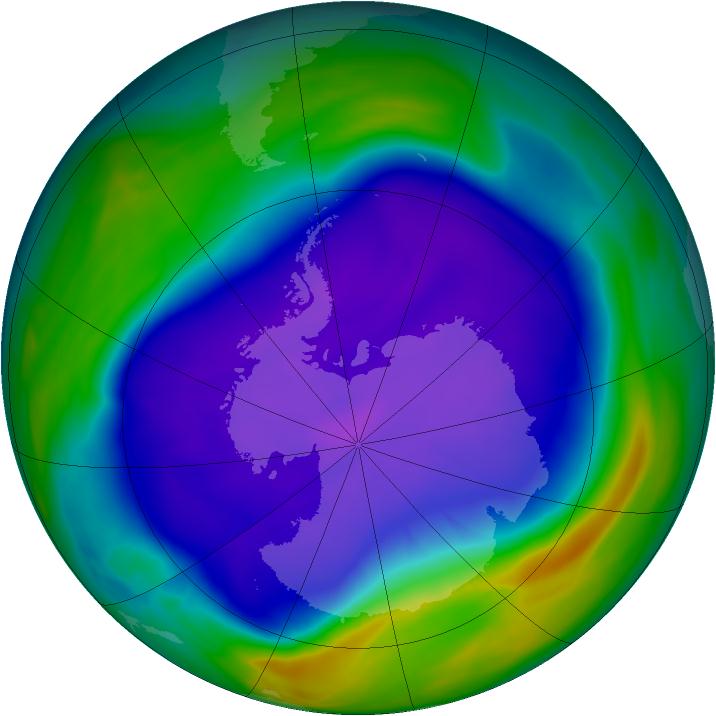|
27 January 2014
Antarctic ozone recovery will be a long and bumpy road
This, the biggest hole in September 2006, was matched in 2011 despite the downward trend. NASA It’s been nearly 30 years since the discovery of the ozone hole over Antarctica, and the realisation that chlorine, in the form of chlorofluorocarbons or CFCs, was the chemical culprit behind the depletion of the ozone layer. While the Montreal Protocol and its amendments severely restricted production of CFCs from 1996, they have very long atmospheric lifetimes, and are still abundant high in the stratosphere even though they have been regulated in developed countries for almost 20 years. Our recent studies have examined the latest satellite observations and meteorological data to look for signs of improvement in ozone levels, to see how factors such as wind and temperatures affect the hole, and judge what impact the Montreal Protocol has had on Antarctic ozone. Defining the ozone hole The hole is a seasonal depletion of most of the stratospheric ozone over Antarctica. The drop to low levels begins in August and reaches a maximum between September and October – the southern hemisphere’s spring. This occurs because the extremely low temperatures during the Antarctic winter between June and August allow ice clouds to form in the stratosphere. The chemical reactions that occur on the ice particles process the chlorine into a reactive form that destroys ozone. Those reactions only end when all the ozone is destroyed, or when the air warms with the changing seasons and mixes with air from lower latitudes. Space-based ozone measurements have been made nearly every day since 1979. Scientists use column measurements to assess the depth and area of the ozone hole. An ozone column, measured in Dobson Units, is the total amount of ozone in the atmosphere above a point on the earth’s surface. The “hole” is defined as the area where ozone measures less than 220 Dobson Units. In the 1980s, the fast growth of CFC emissions saw the ozone hole increase in size rapidly. Although stratospheric chlorine levels kept increasing until 2000, by the early 1990s they had already reached the levels necessary to destroy virtually 100% of the ozone over the Antarctic, and the hole’s growth levelled off. Since reaching this saturation point, the hole’s size has been controlled by temperature. Warmer winters have fewer stratospheric ice clouds and deplete less ozone, colder winters have more clouds and deplete more. But simply measuring the total ozone in a column over one area has limitations – it doesn’t reveal the complexity of how ozone levels are affected by chemistry or weather at different altitudes. New measuring instruments like the Aura Microwave Limb Sounder (MLS) and the Suomi Ozone Mapping Profiler Suite (OMPS) allow us to look inside the ozone hole and measure the distribution of ozone and other important gases, which gives a more accurate indication of how severe the loss of ozone is. New insight from inside the ozone hole How high ozone levels are in early winter, before depletion occurs, affects how low the ozone column will be in October. If Antarctic ozone levels are lower than usual at the start of winter, for example due to the variability of stratospheric winds, then it can end lower than usual. For example, in 2011 the ozone hole was nearly as deep and large as 2006, the largest recorded hole on record. But there was less overall ozone depletion in 2011 because there was less ozone to start with. So despite there being quite a lot less chlorine in the atmosphere that year, it was still enough to destroy nearly all the ozone. A smaller hole doesn’t mean recovery. In 2012, the Antarctic ozone hole was the second smallest since the early 1990s. The ozone vertical profiles measured by OMPS in the centre of the hole showed severe depletion in the lower stratosphere (below 22km) starting from mid-September. What does this tell us? It means that the area is still sufficiently saturated in chlorine to destroy nearly all the ozone. OMPS readings also show that ozone above 22km increased in October 2012, due to winds. Viewed as a column, the higher ozone levels above 22km masks the lack of ozone below, which gives the false impression that the overall ozone depletion is less severe than it actually is. Observations from the MLS of trace gases such as nitrous oxide inside the ozone hole indicate that chlorine levels vary more than we expected from the Montreal Protocol. These are caused by year-to-year variations in stratospheric winds, and can be 5-10 times larger than the expected annual decline. So it seems the road to recovery will be bumpy. As chlorine levels gradually drop, wind variations in some years will produce a big enough downward slump in chlorine to reduce the size and severity of the ozone hole. But in other years, wind variations may produce an upward bump in chlorine, and if it’s cold as well, the ozone hole will be large and deep. While this could last until the 2030s, beyond then ozone levels should consistently increase and the hole should be consistently smaller than it is today, setting us on a path to recovery by about 2070, give or take a decade. http://theconversation.com/antarctic-ozone-recovery-will-be-a-long-and-bumpy-road-22429 |




